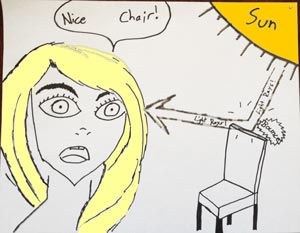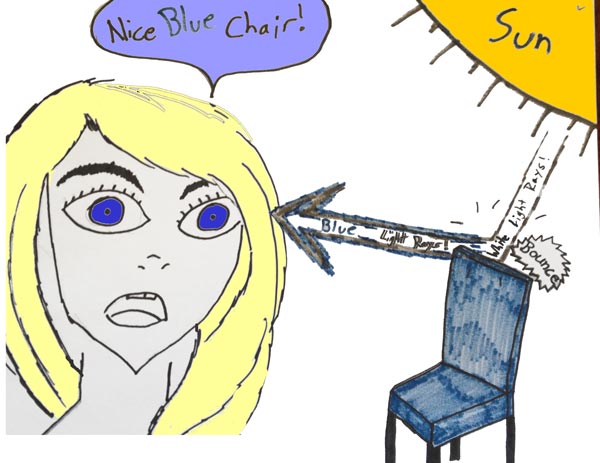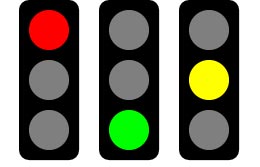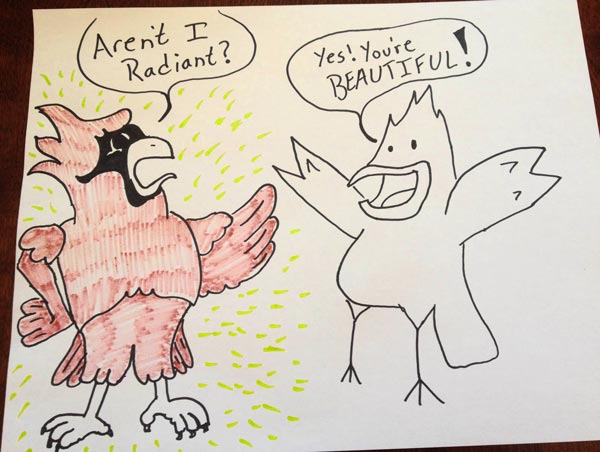Here at High Trails, one of the most discussed adaptations organisms have is that of sight. And we know what sight is: the ability for our eyes to detect light.
But…how do we actually see? Why do we actually see what we do see?
Questions of color blindness and issues of rods and cones often flood our students’ brains. Stick around and read about light and its effect on our eyes and the eyes of other organisms.
What is Vision all About?
 In order for us to see anything there has to be a source of light (that’s why you can’t see anything in the pitch-dark). Whether it’s the sun, a fire, a headlamp, or a fluorescent light bulb, light comes from the source and spreads everywhere.
In order for us to see anything there has to be a source of light (that’s why you can’t see anything in the pitch-dark). Whether it’s the sun, a fire, a headlamp, or a fluorescent light bulb, light comes from the source and spreads everywhere.
When that light hits an object, say a chair, some of the light is absorbed, and some is reflected. If the reflected light then enters your eye, your brain detects the object. Refer to the figure for a pictorial representation.
Now, when our eyes see color, that is because some of the light that hits an object gets reflected, and some absorbed. Let’s pretend the chair in the previous example is blue. Light from the sun (white light – made of all colors of the rainbow) hits the chair and all colors except blue get absorbed. Since blue is reflected, our eyes detect blue – the chair MUST be blue!
Our eyes detect the light from the sun (and other sources) because our eyes are designed that way. But in fact, the light leaving the sun comes in many different varieties – different wavelengths and frequencies all traveling at 2.99×108 m/s (about 186,000 miles per second). Our eyes are adapted to only see some of that light, called visible light. Visible light and the other types of light combine to form what scientists call the electromagnetic spectrum, basically the different types of energy/light leaving the sun. Some animals are able to see these other types of light. I’ll discuss more on this later.
What are Rods and Cones all About?
As discussed previously, our eyes are designed to detect light.
The front of our eye acts like a gatekeeper of light. The pupil and lens help to regulate how much light enters the eye and directs it to the retina. The retina is where light is focused and thus detected by the brain. The retina is kind of like an archery target. The light is focused in the center. This is where the cones of our eyes are located. Outside of the center is where the rods are located. Cones and rods are the light-sensors we use to see.
Cones detect color while rods detect shapes, movement, and brightness.
We have about six million cones in the center of each eye, and about one hundred million rods! Since the center of our vision is packed with cones, it makes sense that we see the color of the thing we are staring at.
What you might not know is that our peripheral vision comes from rod receptors. Since rods don’t detect color, our peripheral vision is colorblind. Our brains fill in the colors around us based on environmental cues.
You can test this idea by holding a bunch of different colored markers behind your back. Stare straight in front of you and select one marker (still out of sight). Slowly move the marker at arms-length into your field of vision from behind your back. Chances are you won’t be able to tell its color until it is close to your center of vision.
Furthermore, our cones only work in the daytime. And since our rods detect movement and brightness, they are “more aware” at nighttime. While your eyes become accustomed to the dark, your center of vision will start to fade as your peripheral vision takes over.
You can witness how rods take over by staring at a friend’s face for about a minute at night. You should notice their head “disappears” as your eyes stop focusing on the center of vision and start focusing on the peripheral.
Colors
But when it is still light out and we are able to see the colors of nature, what is going on in our cones that allow this to happen? There are three different types of cones: red, blue, and green. When your eyes detect different colors, these cones will send messages to the brain in different concentrations that tells your brain what color something is.
Like mixing paints to create new colors, your cones mix signals to observe different colors of light. For example, when you see something that is red, that’s because your red cones are signaling your brain while your blue and green cones are not. When you see something yellow, your red and green cones are both signaling your brain at the same time. The result of this mixing of red and green is the color yellow.
How are Human Eyes Different than Animal Eyes?
Not all eyes are the same in the animal kingdom; different animals see colors differently. We humans are lucky enough to have three different cones in our retina. Cats and dogs only have two – they’re missing the red cone. Although they see colors, they can’t see all the colors we do. Just like people that are color blind, cats and dogs have a hard time telling different colors apart.
What some animals lack in color perception, they make up for in more rods in their eyes, making them better able to see at night. Nocturnal animals like owls have far more rods than cones. And although their eyesight may not be great in the daytime, their ability to see is far better than humans.
Remember the electromagnetic spectrum from before? Well, as it turns out, different animals can see more than just visible light. Reptiles, for example, can see part of the spectrum known as infrared. This part is often associated with heat and is often called “heat vision.”
Animals have adapted the ability to see different wavelengths in order to survive. Certain birds and insects are actually able to see ultraviolet light. In fact, when viewed through an ultraviolet lens, flower petals look like landing strips to butterflies and other insects looking for a snack. Birds use the ability to see ultraviolet light when finding mates. A feather coat that might look plain to human eyes may be irresistibly shiny to birds looking for a partner. That’s because the ultraviolet light shines off feathers and makes a flashy appearance. (picture of radiating bird)
Yes, vision is an awesome adaptation.
It helps organisms survive. But not all eyes are made the same. Next time you look at a pretty flower, remember that some of nature’s spectacles aren’t seen the same way to all creatures.
References:
- http://static.sewanee.edu/Chem/Chem&Art/Detail_Pages/ColorProjects_2003/Early/index.htm
- http://www.smithsonianmag.com/science-nature/new-study-shows-that-dogs-use-color-vision-after-all-13168563/?no-ist
- Stewart, Melissa. Why Do We See Rainbows? New York: Marshall Cavendish Benchmark, 2009. Print.
At High Trails Outdoor Science School, we literally force our instructors to write about elementary outdoor education, teaching outside, learning outside, our dirty classroom (the forest…gosh), environmental science, outdoor science, and all other tree hugging student and kid loving things that keep us engaged, passionate, driven, loving our job, digging our life, and spreading the word to anyone whose attention we can hold for long enough to actually make it through reading this entire sentence. Whew…. www.dirtyclassroom.com






Comments are closed.